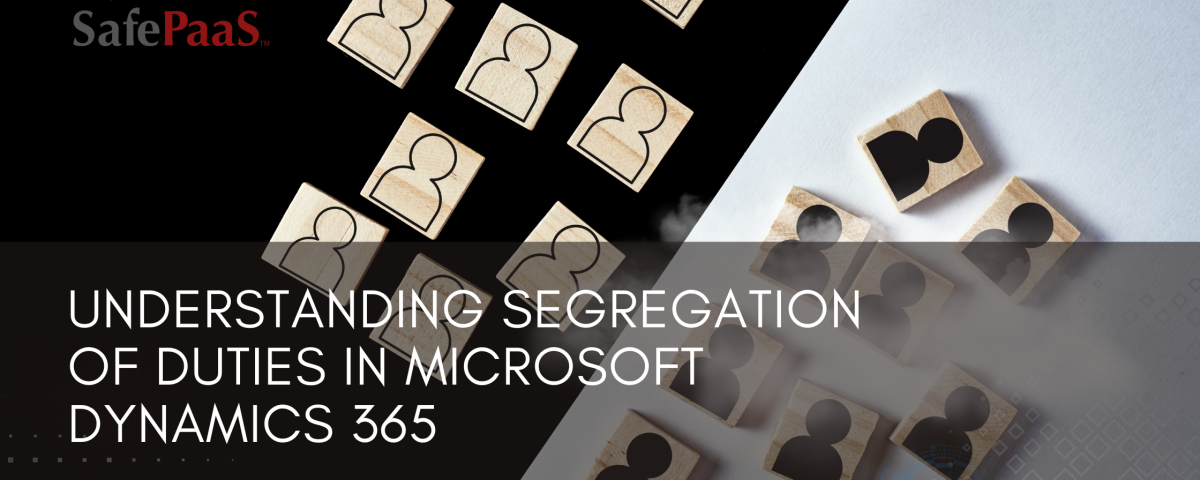Segregation of Duties in Microsoft Dynamics 365


Understanding Segregation of Duties
in Microsoft Dynamics 365
Segregation of Duties (SoD) is a crucial component of internal control, particularly in the context of implementing an ERP system such as Microsoft Dynamics 365. It aims to prevent any single user from having unchecked control over specific actions within your financial system to minimize the risk of fraud and errors. Microsoft Dynamics 365 provides built-in tools to manage Segregation of Duties risks, but it is essential to understand its functionalities and limitations for effective risk management.
Common Challenges with Segregation of Duties in a Microsoft Dynamics 365 Implementation
The implementation of Microsoft Dynamics 365 poses some challenges, especially regarding the design of roles, conflicts in Segregation of Duties, and the under-utilization of system functionality for maintaining controls.
The complexity of role design often results in conflicts and vulnerabilities if not remediated appropriately. Additionally, the default roles provided by Microsoft may not always align with the specific needs of your organization, requiring customization and careful consideration of Segregation of Duties (SoD) policies.
Practical Steps to Mitigate Segregation of Duties Risks
Addressing these challenges requires a proactive approach and practical steps to mitigate Segregation of Duties risks effectively:
1. Customizing Role Design: Tailoring standard roles to fit the organizational hierarchy and business processes is crucial. Custom roles should be crafted to mitigate conflicts and align with Segregation of Duties principles, with compensating controls applied where necessary.
2. Employing Segregation of Duties Solutions: Microsoft Dynamics 365 provides pre-built Segregation of Duties tools that can recognize possible risks in the system. However, these tools may not be enough to handle controls effectively. To address this, it is recommended to utilize Access Governance solutions and create customized rulesets based on current business processes. By doing so, potential conflicts can be minimized, and Segregation of Duties policies can be enforced more effectively.
3. Implementing Automated Workflows: Automated workflows across key finance cycles can significantly reduce Segregation of Duties conflicts. These workflows should enforce approval hierarchies and monetary limits, preventing individuals from initiating and approving transactions independently.
4. Taking Proactive Measures: Prioritizing proactive measures such as removing conflicting permissions before system deployment and establishing security matrices can help in controlling Segregation of Duties risks and ensuring effective control implementation.
Avoiding Common Pitfalls
It is important to identify and address common mistakes that can compromise the security of your Microsoft Dynamics 365 environment. Some of these mistakes include assigning too many system administrator roles, using generic rulesets, relying solely on out-of-box roles, and not involving all relevant stakeholders in the implementation process. Avoiding these pitfalls can help you optimize the security of your Dynamics 365 environment and reduce the risk of security breaches.
It is crucial to effectively manage Segregation of Duties risks while implementing Dynamics 365 to maintain internal control, minimizing fraud risks, and improving operational efficiency. To ensure success in the Dynamics 365 journey, organizations must comprehend the challenges, implement practical measures, and avoid common pitfalls.
Enhancing SoD Management in Dynamics 365: Best Practices and Additional Considerations
While the steps outlined above provide a solid foundation for managing Segregation of Duties risks in Microsoft Dynamics 365, there are additional best practices and considerations that you can combine to enhance your internal control environment further:
1. Continuous Monitoring and Review: Segregation of Duties risks evolve, and new risks may emerge as business processes change or new features are introduced in Dynamics 365. Implementing a solution for continuous monitoring and regular review of roles, permissions, and access rights is crucial for staying ahead of potential vulnerabilities.
2. Segregation Beyond Financial Functions: While financial functions are often the primary focus of Segregation of Duties controls, it's essential to extend segregation principles beyond finance to other critical areas such as procurement, human resources, and IT. Each department may have its unique set of tasks and responsibilities that require segregation to prevent conflicts of interest and ensure accountability.
3. Integration with Access Governance Solutions: Integrating Dynamics 365 with robust Access Governance solutions can streamline access management processes and enhance SoD controls. Access Governance solutions offer advanced features such as policy-based access control (PBAC), multi-factor authentication (MFA), and control automation, which can complement Dynamics 365's native security features.
4. External Audits and Assessments: Engaging external auditors or security professionals to conduct periodic assessments and audits of your Dynamics 365 environment can provide valuable insights and validate your internal controls. External assessments can uncover blind spots, identify areas for improvement, and ensure compliance with regulatory requirements and industry standards.
5. Control Documentation: Maintaining comprehensive documentation of Segregation of Duties rules, roles, permissions, and access controls is essential for transparency, accountability, and auditability. Documenting changes to roles and permissions, as well as the rationale behind those changes, ensures that there is a clear record of who has access to what and why.
7. Updates and Patch Management: Keeping Dynamics 365 up to date with the latest patches, updates, and security fixes is critical for addressing known vulnerabilities and minimizing the risk of security breaches. Implementing a patch management process ensures that your system is protected against emerging threats and vulnerabilities.
Incorporating the best practices and considerations for Segregation of Duties management can help to strengthen your internal controls, minimize the risk of fraud and errors, and ensure accurate financial statements. Adopting a proactive and comprehensive approach to Segregation of Duties management in Microsoft Dynamics 365 can help organizations maximize the value of their ERP investment and safeguard their critical business processes.
If you´d like to learn more about how SafePaaS can help your organization with effective risk management for Microsoft Dynamics 365, contact us.
Recommended Resources

The Policy-based Identity Governance Guidebook
Many organizations grapple with IGA processes, like creating and managing roles, assigning and reviewing access entitlements, and handling access requests. The primary cause is that organizations follow the wrong approach to IGA, particularly around creating and managing roles.

Everything you need to know about Segregation of Duties
Join us on an informative journey as we navigate the complexities of maintaining a secure and compliant organizational environment. We aim to provide you with the knowledge to make informed decisions, fortify your organization's internal structure, and ensure a resilient foundation for sustained success.

Segregation of Duties and Fraud
Without SoD, a business may inadvertently create an environment ripe for fraud. Imagine a scenario where a single employee has the authority to both initiate and approve financial payments. In such a situation, the potential for financial misconduct, whether intentional or accidental, significantly increases.

